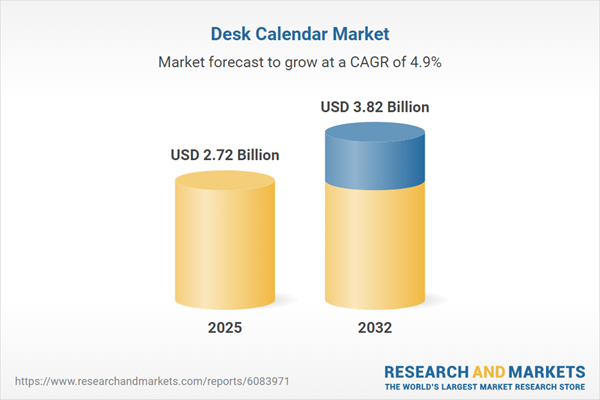Speak directly to the analyst to clarify any post sales queries you may have.
The desk calendar market is experiencing dynamic change as organizations worldwide seek greater customization, digital integration, and resilient supply models to meet evolving business and consumer needs.
Market Snapshot: Desk Calendar Market
The desk calendar market expanded from USD 2.59 billion in 2024 to USD 2.72 billion in 2025 and is projected to grow at a CAGR of 4.93%, reaching USD 3.82 billion by 2032.
The primary keyword for this analysis is “desk calendar market.” These steady gains reflect broad demand across corporate, educational, and personal end users as products shift in design, material, and channel strategies. The market’s competitive landscape is shaped by transformative technology, robust supply networks, and rising focus on environmental practices, all of which underpin future growth trajectories.Scope & Segmentation
This report explores critical growth areas, detailing key segments and regions that influence buying decisions and operational models. Segmentation covers:
- Format: Spiral bound calendars (metal, plastic), stand alone (adhesive backing, plain), and tent style (cardboard, plastic)
- Page Layout: Daily, monthly, and weekly designs suitable for diverse scheduling needs
- End User: Corporate buyers (large, small enterprises) and educational institutions (K-12 schools, universities)
- Distribution Channel: Offline (department stores, direct sales) and online retail (brand websites, e-commerce platforms)
- Geographic Regions: Americas (North America—United States, Canada, Mexico; Latin America—Brazil, Argentina, Chile, Colombia, Peru), Europe, Middle East & Africa (Europe, Middle East, Africa), Asia-Pacific (China, India, Japan, Australia, South Korea, Indonesia, Thailand, Malaysia, Singapore, Taiwan)
- Key Players: Major companies include ACCO Brands Corporation, FranklinCovey Co., Lang Companies LLC, TF Publishing Inc., House of Doolittle LLC, Peter Pauper Press Inc., Charles Leonard Inc., Galison LLC, Cambridge Company Inc., and TriCoastal Distribution LLC
Key Takeaways for Senior Decision-Makers
- Spiral bound and tent style desk calendars are favored in segments emphasizing durability and on-desk visibility, supporting diverse enterprise branding goals.
- Customization trends, such as tailored cover designs and interactive note sections, have resulted in widespread adoption of agile manufacturing and on-demand printing for shorter lead times.
- Increasing adoption of hybrid calendars integrates paper with digital features, offering advanced user interaction and compatibility with electronic devices.
- Eco-friendly material use, including recyclable and biodegradable options, drives brand differentiation and meets emerging sustainability standards across regions.
- Blending online and offline channels creates a seamless omnichannel purchasing journey, supporting rapid customization and broad customer access.
- Regional preferences—such as vibrant design themes in Latin America or premium finishes in Western Europe—necessitate localization of offerings to maintain relevance and competitive positioning.
Tariff Impact on the Desk Calendar Market
The introduction of new United States tariff measures in 2025 has added notable supply chain challenges, prompting manufacturers to adapt their sourcing and operational strategies. Many businesses are investing in local production and seeking out tariff-exempt suppliers. This shift enhances agility while protecting profit margins amid cost volatility. Closer partnerships with domestic production specialists and direct engagement with channel partners are helping offset increased duties and streamline order fulfillment, ensuring delivery timelines remain competitive even as trade complexities persist.
Methodology & Data Sources
This research applies a rigorous mixed-methods approach. Structured executive interviews and stakeholder surveys inform qualitative insights on purchasing preferences and market challenges. Comprehensive secondary data—industry reports, trade publications, and financial disclosures—validate trends and enable robust scenario modeling. Quantitative performance metrics and regional economic profiles form the analytical foundation, ensuring accuracy and actionable guidance for strategic decision-making.
Why This Report Matters
- Enables executives and procurement leads to benchmark product, channel, and material strategies relative to evolving global norms and competitive pressures.
- Provides clarity on market segmentation and shifting demand drivers, allowing targeted investment in high-potential regions and product segments.
- Supports risk mitigation by outlining the impact of tariffs and supply chain diversity strategies on cost management and delivery timelines.
Conclusion
Agile adaptation, technology-driven innovation, and proactive supply chain management are central to success in the evolving desk calendar market. This report equips stakeholders with strategic insights to identify growth opportunities and drive future-ready decisions.
Table of Contents
3. Executive Summary
4. Market Overview
7. Cumulative Impact of Artificial Intelligence 2025
Companies Mentioned
The companies profiled in this Desk Calendar market report include:- ACCO Brands Corporation
- FranklinCovey Co.
- Lang Companies, LLC
- TF Publishing, Inc.
- House of Doolittle, LLC
- Peter Pauper Press, Inc.
- Charles Leonard, Inc.
- Galison, LLC
- Cambridge Company, Inc.
- TriCoastal Distribution, LLC
Table Information
| Report Attribute | Details |
|---|---|
| No. of Pages | 194 |
| Published | November 2025 |
| Forecast Period | 2025 - 2032 |
| Estimated Market Value ( USD | $ 2.72 Billion |
| Forecasted Market Value ( USD | $ 3.82 Billion |
| Compound Annual Growth Rate | 4.9% |
| Regions Covered | Global |
| No. of Companies Mentioned | 11 |









